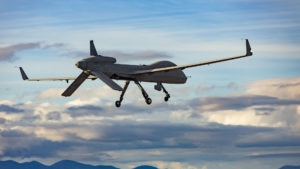
General Atomics said on Tuesday that it sees an expansion of the role of the company’s Gray Eagle-Extended Range (GE-ER) unmanned aircraft system (UAS) in the U.S. Army’s Future Vertical Lift (FVL) program.
“General Atomics anticipates the role of the GE-ER to expand as the Army develops the payloads to enable longer range detection, identification, location and reporting of targets in both its role as an intelligence platform and as a reconnaissance asset,” General Atomics Aeronautical Systems Inc. (GA-ASI) wrote in response to questions from Defense Daily. “GE-ER with MDO (multi-domain operations) capabilities is designed to evolve with the needs of the Army to continue to support and complement FVL platforms and other [Army] Futures Command concepts.”
First flown in 2013, GE-ER has an endurance of 42 hours, compared to an advertised endurance of 25 hours for the standard MQ-1C Gray Eagle, and features a maximum gross takeoff weight of 4,200 pounds and a 180 horsepower engine, versus a maximum gross takeoff weight of 3,600 pounds and a 160 horsepower engine on the conventional Gray Eagle. GA-ASI said that GE-ER doubles endurance and range of the standard Gray Eagle and can carry 1,350 pounds of fuel–900 internally and 450 externally, compared to 600 pounds of fuel carrying capacity on the conventional Gray Eagle.
GE-ER “also comes with upgrades to communications, engine and datalinks,” GA-ASI said. “Designed and equipped to meet FVL’s Modular Open Systems Architecture (MOSA), these enhancements increase the survivability of the aircraft, as well as improve its ability to operate in a GPS and SATCOM denied environment.”
“The open architecture allows for rapid, low-cost, low-risk integration of advanced payloads that allow the GE-ER for MDO to operate as a stand-off asset with stand-in capabilities to shape the battlefield in unprecedented ways,” according to GA-ASI. “These capabilities and concepts of operation were proven highly effective in Army models and simulations and live tests against a simulated Integrated Air Defense System (IADS) threat. In each test, the MDO-equipped GE-ER not only survived throughout the fight, it contributed significantly to the effectiveness of Enhanced Range Cannon Artillery (ERCA) Long-Range Precision Fires. It increased the effectiveness, survivability and freedom to maneuver for the manned aviation and ground maneuver elements.”
GA-ASI also discussed its work with the California-based UAS Consulting Group, LLC and the Alabama-based Trideum on Project Heresy, which includes multi-mission control (MMC) software to allow the simultaneous control of six drones.
“Our Heresy suite of capabilities continues to develop with new technologies that reduce manpower requirements throughout the Intelligence, Surveillance and Reconnaissance (ISR) lifecycle,” according to GA-ASI. “We are currently developing a new automated method to allocate ISR platforms to tasking in our Metis application, and we are expanding our AutoPED capability to perform multi-intelligence correlation and utilize Artificial Intelligence (AI) to automatically detect unusual behaviors in the maritime domain.”